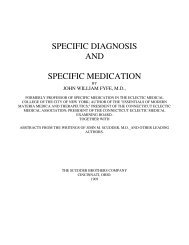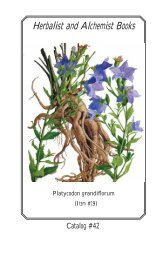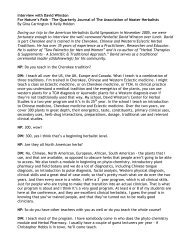MEDlCINAL PLANTS OF JAMAICA. PARTS 1 & 11.
MEDlCINAL PLANTS OF JAMAICA. PARTS 1 & 11.
MEDlCINAL PLANTS OF JAMAICA. PARTS 1 & 11.
Create successful ePaper yourself
Turn your PDF publications into a flip-book with our unique Google optimized e-Paper software.
PASSIFLORA SEXFLORA Juss. Duppy Pumpkin: Bat Wing; Goat or Duck Foot; Passion Flower.<br />
Beckwith states that this plant is used for colds, either alone or with Cissampelos pareiras and as a<br />
plaster for sores, a lame foot or a stiff neck. (2).<br />
PHYTOLACCACEAE<br />
A small family consisting for the most part of shrubby plants of the warmer regions of the world about<br />
which there are chemical data for only a few individual species. Mustard oil, saponins and 'phytolaccic acid' are<br />
among the compounds known for the group.<br />
PETIVERIA ALLICAEA L. Guinea Hen Weed: Strong Man's Weed.<br />
This plant has a strong smell of garlic and the meat and milk of cattle feeding on it acquire a very<br />
disagreeable smell and taste. The plant contains mustard oil. The leaves are rubbed up and sniffed or tied on the<br />
head for headaches while the roots, steeped in white rum, are similarly used. Beckwith records the use of a<br />
decoction with Eryngium foetidum for fever and headaches. Lunan mentions the use of the juice for hysterical<br />
fits. (2, 7, 14, 15, 19, 24, 25, 27).<br />
PIPERACEAE<br />
A large family widely distributed in the tropics of the old world. The leaves contain oil cells. The genus<br />
Piper, for wtich the majority of chemical data are available, contains characteristic pungent principles. Also<br />
found in members of the family are alkaloids, essential oils, resin and bitter principles.<br />
PEPEROMIA PELLUCIDA Kunth. Pepper Elder (Pepper Helda); Rat Ears; Ratta Temper; Silver<br />
Bush; Shinv Bush.<br />
According to Beckwith this plant is used as a tea for a loose cough. In the Grenadines, where it is called<br />
silver bush, it provides a tea for undernourished children. In Africa it is frequently employed in infusions for<br />
convulsions. In Trinidad, where it is called shiny bush, it is used for colds and as a cooling medicine for<br />
children. (2, 28, 13).<br />
PIPER AMALGO L. Joint Wood: Pepper Elder.<br />
The young stem and leaves of this species provide a decoction for flatulence and, according to<br />
Steggerda, serve as a tonic for the blood. Browne says the root is sudorific, diaphoretic and good for dropsy,<br />
and that the leaves and shoots were used in baths and fomentations. The fruits provide an alternative to<br />
commercial pepper. (5, 15, 26).<br />
PIPER NIGRINODUM C.DC. Jointer Bush: Black Joint (Giant); Black Jointer.<br />
For fever and colds the twigs are boiled, the resulting decoction being used as a tea and for a bath. The<br />
bath is also taken for pains and the tea, with ginger added, is used for stomach-ache and as a general beverage.<br />
(2).<br />
PIPER UMBELLATUM L. Cow or Colt's Foot.<br />
For colds this plant is made into a tea, either alone or with other cold bushes. The leaves are tied on the<br />
head for headache and Beckwith says the warmed leaf is applied for lameness, In Lunan's time the root was<br />
used for boils. In parts of Africa the leaves are boiled as a vegetable, and as a remedy for tapeworm while the<br />
roots are used for rheumatism. The leaves and berries contain a pungent volatile oil about which little is known.<br />
(2, 7, 10, 15, 27).<br />
PLANTAGINACEAE<br />
A small family of mainly herbaceous temperate region species. A glycoside aucubin, together with<br />
choline, adenine and succinic acid bas been found in members of the family.







